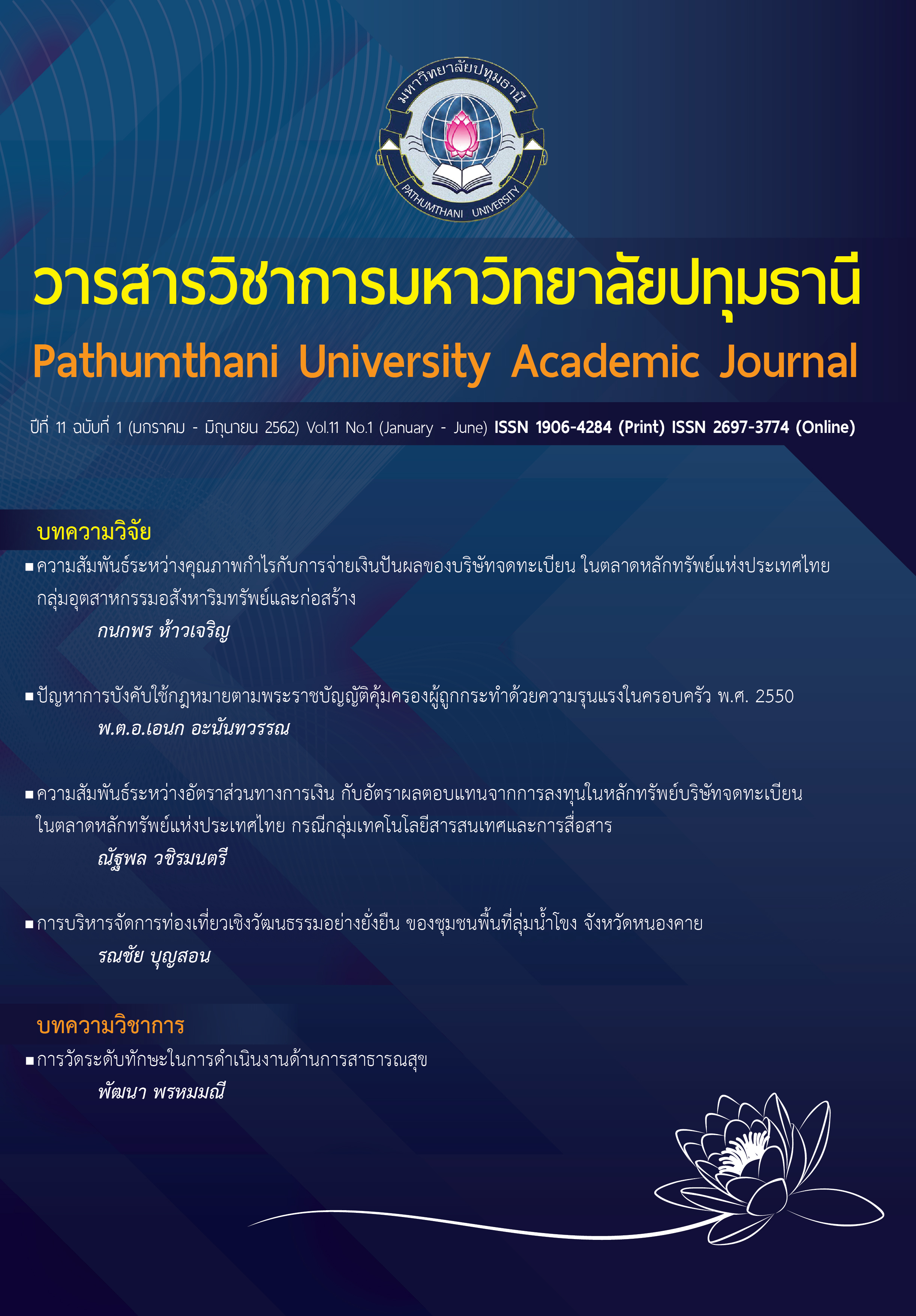The Relationships Between the Conscientiousness, Constructive Styles, and Team Work With A High Performance Organization: A Case Study Of Employees At Panasonic Auto Motive Systems Asia Pacific Co., Ltd.
Keywords:
บุคลิกภาพด้านการมีมโนสำนึก, วัฒนธรรมองค์การลักษณะสร้างสรรค์, การทำงานเป็นทีม, องค์การแห่งความเป็นเลิศAbstract
In this thesis, the researcher investigates (1) the degree to which the conscientiousness, constructive styles, and team work with a high performance organization: a case study of employees at Panasonic Auto Motive Systems Asia Pacific Co., Ltd. (2) the mutual relationships between the conscientiousness, constructive styles, and team work with a high performance organization: a case study of employees at Panasonic Auto Motive Systems Asia Pacific Co., Ltd. (3) the predictive power of the conscientiousness, constructive styles, and team work with a high performance organization: a case study of employees at Panasonic Auto Motive Systems Asia Pacific Co., Ltd. at least 1 variable
The sample population consisted of 261 employees at Panasonic Auto Motive Systems Asia Pacific Co., Ltd. The instrument of research were a questionnaire eliciting data concerning demographical characteristics; a questionnaire regarding a high performance organization; a questionnaire regarding conscientiousness; a questionnaire regarding constructive styles; and a questionnaire regarding team work.
Using techniques of descriptive statistics, the researcher analyzed the data collected in terms of percentage, mean and standard deviation. The researcher also employed Pearson’s product moment correlation coefficient method and the forward selection approach in conducting multiple regression analysis in carrying out this investigation.
Findings are as follows:
- The conscientiousness, constructive styles, and team work were found to be correlated of a high performance organization of employees at Panasonic Auto Motive Systems Asia Pacific Co., Ltd. under study at the statistically significant level of .01.
2. The conscientiousness and constructive styles were found to be predictive of a high performance organization of employees at Panasonic Auto Motive Systems Asia Pacific Co., Ltd. under study at the statistically significant level of .01. Both variables were found to be predictive of a high performance organization at 46.5 and the constructive styles was the best predictor of a high performance organization.
References
ฐิรชัย หงส์ยันตรชัย. การวิเคราะห์เชิงปริมาณทางจิตวิทยาเบื้องต้น (พิมพ์ครั้งที่ 1). พ.ศ. 2549 สำนักพิมพ์มหาวิทยาลัยรามคำแหง.
ธนัชพร โมราวงษ์. (2555). ปัจจัยทางจิตวิทยาองค์การที่มีอิทธิพลต่อการนำไปสู่องค์การแห่งความเป็นเลิศ กรณีศึกษาโรงงานในเขตนิคมอุตสาหกรรมบางปู จ.สมุทรปราการ, วิทยานิพนธ์วิทยาศาสตรมหาบัณฑิต, มหาวิทยาลัยรามคำแหง.
บุญเรียง ขจรศิลป์. (2542). สถิติวิจัย I (พิมพ์ครั้งที่ 7). กรุงเทพมหานคร: พี. เอ็น. การพิมพ์.
ปิยวรรณ สุกษ์ดิษฐ์. (2555). ความสัมพันธ์ระหว่างการรับรู้การสนับสนุนจากองค์การการรับรู้ความยุติธรรมด้านกระบวนการ คุณลักษณะงาน และพฤติกรรมการเป็นสมาชิกที่ดีขององค์การ ของพนักงานบริษัท พานาโซนิค ออโต้โมทีฟ ซิสเต็มส์เอเชีย แปซิฟิค (ประเทศไทย) จำกัด, วิทยานิพนธ์วิทยาศาสตรมหาบัณฑิต, มหาวิทยาลัยรามคำแหง.
เมตตา คงหอม. (2555). ความสัมพันธ์ระหว่างบุคลิกภาพตระหนักในหน้าที่รับผิดชอบบรรยากาศองค์การกับพฤติกรรมการเป็นสมาชิกที่ดีขององค์การของพนักงานในเครือกลุ่มเจริญสิน, วิทยานิพนธ์วิทยาศาสตรมหาบัณฑิต, มหาวิทยาลัยรามคำแหง.
เสาวลักษณ์ ชูภักดิ์. (2557). ความสัมพันธ์ระหว่างรูปแบบการแลกเปลี่ยนความสัมพันธ์ระหว่างผู้นำกับสมาชิกการจัดการคุณภาพทั้งองค์การ วัฒนธรรม องค์การ กับการรับรู้องค์การแห่งความเป็นเลิศ: กรณีศึกษาโรงแรมกะตะ พาเลซ จ.ภูเก็ต, วิทยานิพนธ์วิทยาศาสตรมหาบัณฑิต, มหาวิทยาลัยรามคำแหง.
Blanchard, K. H. (2007). Leading at a higher level: Blanchard on leadership and creating high performance organization. Englewood Cliffs, NJ: Prentice-Hall.
Borman, W. C. (2004). The concept of organizational citizenship. American Pyschology Society, 13(6), 238-241.
Cooke, R. & J. (1989). Organization Culture Inventory. Piymou, MI: Human Synergistics.
Costa, P. T. Jr., & McCare, R. R. (2000). Revised NEO Personality (NEO-PI-R) and NEO five-factor inventory (NEO-FFI) Professional manual. Odessa, FL: Psychological Assessment Resources.
Greenberg, J. & R. A. Baron, (2005). Behavior in Organizations (8th ed.) New Jersey, NJ: Prentice Hall.
Miller, M. L. (2011). The high-performance organization an assessment of virtues and values. Retrieved August 22, 2010. From http:ebbf.org/fileadmin/pdfs/publications/highperformance-organization.pdf
Romig. D. A. (1996). Breakthrough Teamwork: outstanding results using structured teamwork. Texas. Austin.
Yamane, T. (1973). Statistics: An introductory analysis (3rd ed.). New York: Harper & Row.
Downloads
Published
How to Cite
Issue
Section
License
บทความที่ได้รับการตีพิมพ์เป็นลิขสิทธิ์ของวารสารมหาวิทยาลัยปทุมธานี
ข้อความที่ปรากฎในบทความแต่ละเรื่อง เป็นความคิดเห็นส่วนตัวของผู้เขียน กองบรรณาธิการไม่จำเป็นต้องเห็นด้วยเสมอไป และไม่มีส่วนรับผิดชอบใด ๆ ถือเป็นความรับผิดชอบของผู้เขียนแต่เพียงผู้เดียว



